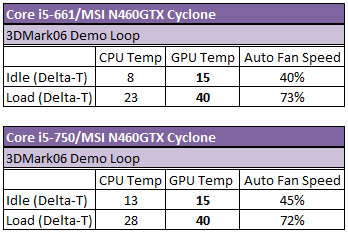
Lian Li PC-Q11: Test Setup
- Intel Core i5-661 at 3.33GHz (25x133MHz) and Core i5-750 at 2.66GHz (20x133MHz);
- Intel LGA1156 reference CPU cooler
- Gigabyte H55N-USB3 mini-ITX motherboard
- 4GB Crucial Ballistix 1,600MHz DDR3 memory (set to 1,333MHz SPD)
- Seasonic X-Series 650W PSU
- 2x Western Digital Green 500GB hard drive
- 80GB Intel X-25M G1 SSD (boot drive)
- MSI N460GTX Cyclone 768MB graphics card
- Windows 7 Home Premium x64
As mini-ITX cases are a bit of an oddity, we test them in a different way to standard-sized cases. As mini-ITX boards can accept dual- and quad-core CPUs, we want to see whether the cooling system of a case can handle both. We also find out if the case can house a gaming system or whether it's only for a work PC that uses integrated graphics. Our stress test uses the smallfft test of Prime95 and the Canyon Flight test of 3DMark06.
Lian Li PC-Q11: Results

With a Core i5-661 installed the CPU ran hot under sustained load but was still stable. The large 14cm intake fan also cooled the Q11 off very quickly when Prime95 was stopped. Understandably the Intel reference CPU cooler had spun up to its full speed to compensate, and was notably loud too.
The Q11 cannot take a quad core CPU though. Even at stock speed and voltage, we found our i5-750 was hitting its thermal limit and throttling with Prime95. While the cooler is limited, the intake fan supporting it with cool air could obviously be better.

You'll notice on the previous page that in the picture with our MSI N460GTX Cyclone installed that the front case fan doesn't cover it for cooling. This basically creates two cooling zones within the case, because the graphics card PCB acts as a separator for airflow, meaning cooling in the lower half of the case was limited. With a relatively high power graphics card this area becomes a hot zone too, with the heat of the GPU cooking the hard drives. After 30 minutes of 3DMark06 looping we found our hard disks were running at just over 50OC.
A graphics card with an exhaust blower will remove that heat to some extent, but as modern graphics cards are designed to run hot to keep the fan noise down, it'll still radiate heat into a mostly stagnant area. Basically this means you can either have a gaming graphics card or have hard disks - SSDs are unaffected.
On a positive note, throughout the 3D test, the system remained completely stable and usable with either a Core i5-750 or i5-661 installed, meaning the case can still make a very small and portable gaming system - providing you're happy to invest in an SSD. Versus the Silverstone SG07 or the Lian-Li Q08 though, you'd have more choice and better cooling with them.

MSI MPG Velox 100R Chassis Review
October 14 2021 | 15:04








Want to comment? Please log in.